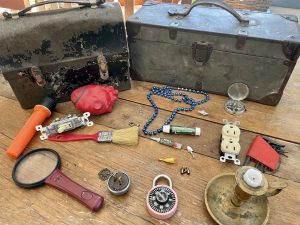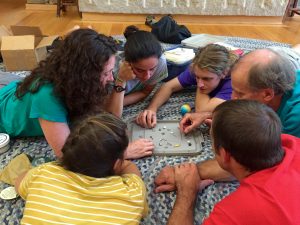Oct 23, 2021 Miniature Metaphors/Found Object Reflection
 Inspire meaningful reflection and dialogue that goes beyond the traditional sharing circle. Spark reflective writing, exploration of positive character traits, or facilitate strong beginnings and optimistic endings. This method is useful for both individual and collaborative reflection and is used in restorative circles and appreciations, group norms conversations, and goal setting.
Inspire meaningful reflection and dialogue that goes beyond the traditional sharing circle. Spark reflective writing, exploration of positive character traits, or facilitate strong beginnings and optimistic endings. This method is useful for both individual and collaborative reflection and is used in restorative circles and appreciations, group norms conversations, and goal setting.
People often find it easier to express themselves through an object or symbol rather than through verbal means. Because participants can talk about the object rather than about themselves directly, they sometimes express thoughts that would otherwise be left unsaid. The thoughts, ideas and connections inspired by the imagery lead to broader and deeper reflection sessions than when using dialogue alone. This approach can be especially helpful for more introverted or reluctant group members (Stanchfield,2016).
I use this tool when engaging participants in individual reflection or as a collaborative group reflection. The collaborative method stimulates group dialogue, puts group norms into practice to problem solve as a team, respect a diversity of ideas, and build consensus. It is also an excellent way to focus on visioning and group goal setting. The power of the activity is in the process of choosing the object as a group.The individual method sparks introspection regarding emotions, strengths, goal setting, and can be used with journal writing.
Materials: A collection of objects. These could be found object items from your junk drawer, yard sales, household objects, or from nature. I have created a collection of miniature charms for this purpose that I call Miniature Metaphors.
 Remember that the container you choose to display your reflective object collection sparks interest and engagement in the activity. The container or box you display the objects in stimulates interest and engagement in the activity. I love to use vintage toolboxes and lunchboxes for my larger found object collection. My Miniature Metaphors are packaged in a hand designed decorative tin. These are available through my website: Miniature Metaphors Reflection Treasure Chest.
Remember that the container you choose to display your reflective object collection sparks interest and engagement in the activity. The container or box you display the objects in stimulates interest and engagement in the activity. I love to use vintage toolboxes and lunchboxes for my larger found object collection. My Miniature Metaphors are packaged in a hand designed decorative tin. These are available through my website: Miniature Metaphors Reflection Treasure Chest.
Facilitation Suggestions:
For Individual Focused Reflection:
- Display the charms/objects in an accessible space so that all group members can interact with them.
- Invite participants to pick an object that represents their unique perspective or experience. Possible prompts could include:
- The key learning they are taking away from the experience.
- Their role in the activity or group process
- Their emotions or lessons learned from the experience
- Their perspective on what the group achieved together
- Their strengths or achievements
- A personal commitment or goal
- You might ask participants to draw or write about it in their journals.
- As a memento of experience and to carry the reflection beyond the experience, invite participants to keep the object that represents their strength or achievements. Or take a photo that they can keep as a reminder. See Memento of Experience Article from Tips & Tools for the Art of Experiential Group Facilitation.
For Collaborative/Group Consensus Reflections:
- Display the charms/objects in an accessible space so that all group members can access them.
- Invite participants to collaborate on one of these possible reflective prompts about their shared experience:
- Agree on one object that best represents the collective group experience, strengths, or achievements.
- Choose three objects that represent the story of their journey together, one representing where they were at the start of their time, together, the second to represent where they are now, and the third, where they hope to be in the future
- Pick three objects that represent three important skills used in an activity that can be useful in upcoming activities. Have them carry these objects with them and find a way to integrate them into the next activity or refer back to them to illustrate transfer of skills/learning to future situations.
- Choose an object in celebration of the strengths and contributions another person lent to the experience.
- The power of the activity is in the process of choosing and agreeing on the object and symbolism. Optionally, extend the activity by asking the group to arrange the images in a meaningful way and share their collective story with another group.
- Take a picture of the selected objects or if possible, have the group keep them as a reminder for future reflection and accountability.
 This reflection technique will help you go beyond the standard What, So What, Now What? processing of an experience. It enhances involvement and ownership by allowing participants to take more initiative in interpreting the experience and lessons learned. It is brain based because metaphors and symbols stimulate multiple areas of the brain and involve all senses. I use the Miniature Metaphors as a “Hook to Engage” or “Welcoming Ritual.” As an optimistic ending or closing gift. I also use them in English classes to stimulate exploration of metaphor or character and character traits. When participants can talk about a tangible object instead of themselves directly they are more comfortable and willing to share with the group. (Stanchfield, 2016). Use your creativity. The possibilities are endless.
This reflection technique will help you go beyond the standard What, So What, Now What? processing of an experience. It enhances involvement and ownership by allowing participants to take more initiative in interpreting the experience and lessons learned. It is brain based because metaphors and symbols stimulate multiple areas of the brain and involve all senses. I use the Miniature Metaphors as a “Hook to Engage” or “Welcoming Ritual.” As an optimistic ending or closing gift. I also use them in English classes to stimulate exploration of metaphor or character and character traits. When participants can talk about a tangible object instead of themselves directly they are more comfortable and willing to share with the group. (Stanchfield, 2016). Use your creativity. The possibilities are endless.
Source/References:
I created the Miniature Metaphor Processing Treasure Chest upon the request of an Outward Bound instructor who attended one of my reflection workshops in 2002. When I showed him my big reflection toolbox, he asked if I had something small he could carry into the field – which sparked the idea of using figural charms. Since that time, they have been used by classroom teachers, therapists, coaches-facilitators of all kinds. Other objects I’ve used in a similar way include seashells and other items from nature, a toolbox full of tools, re-purposed computer keyboard keys, toy animals, and paint chips. For more about using metaphor in reflection check out Tips & Tools for the Art of Experiential Group Facilitation.



No Comments